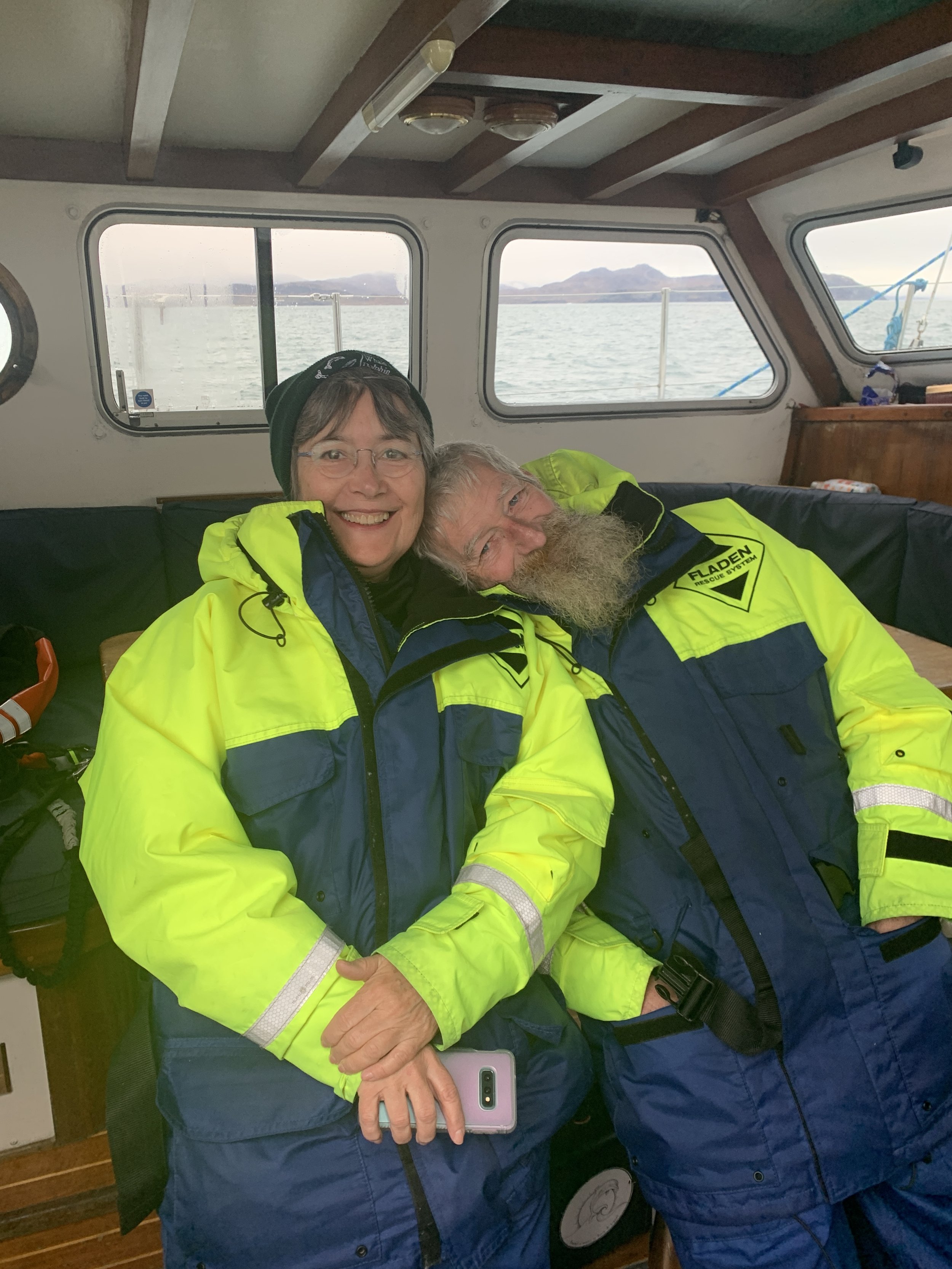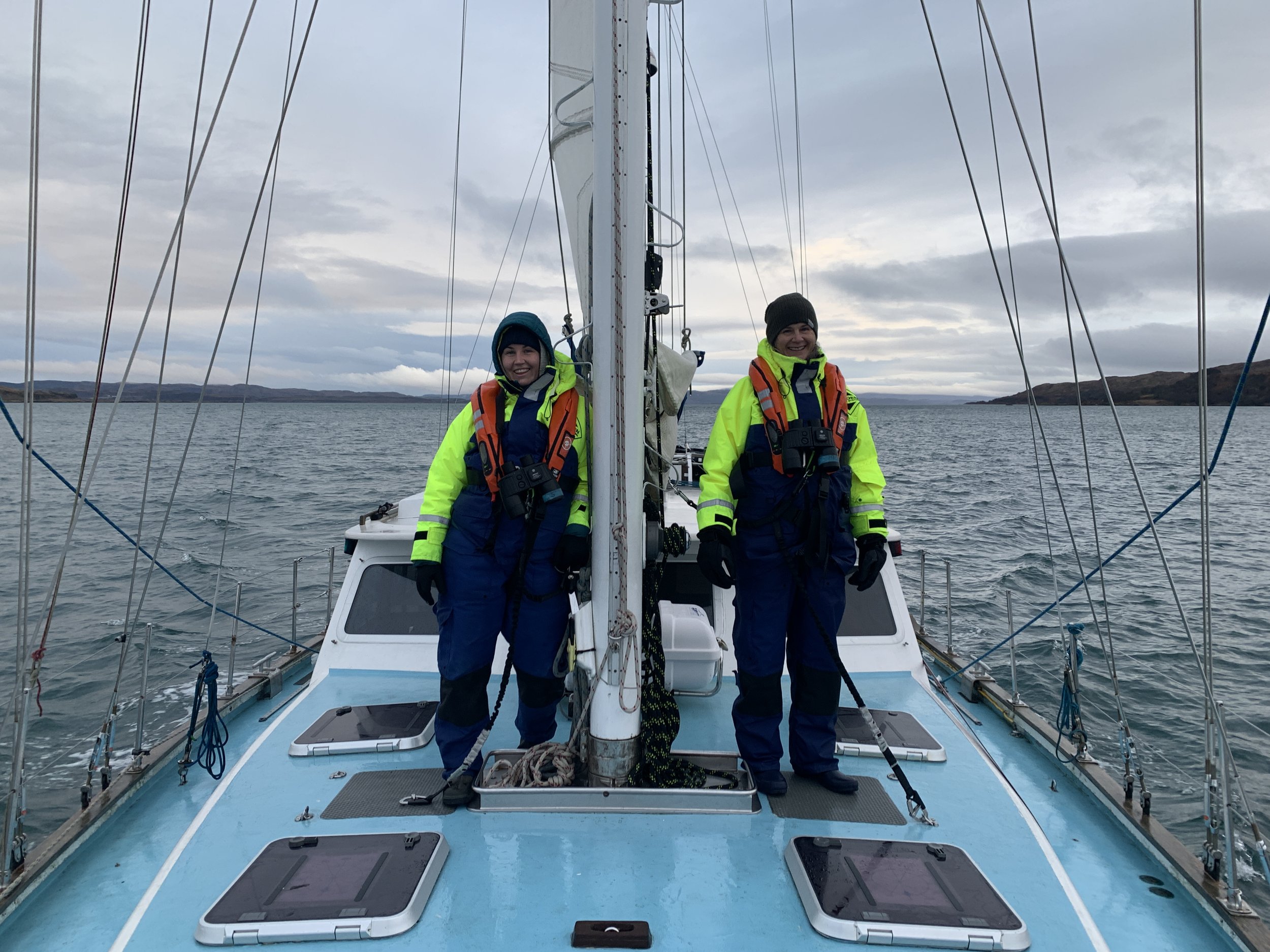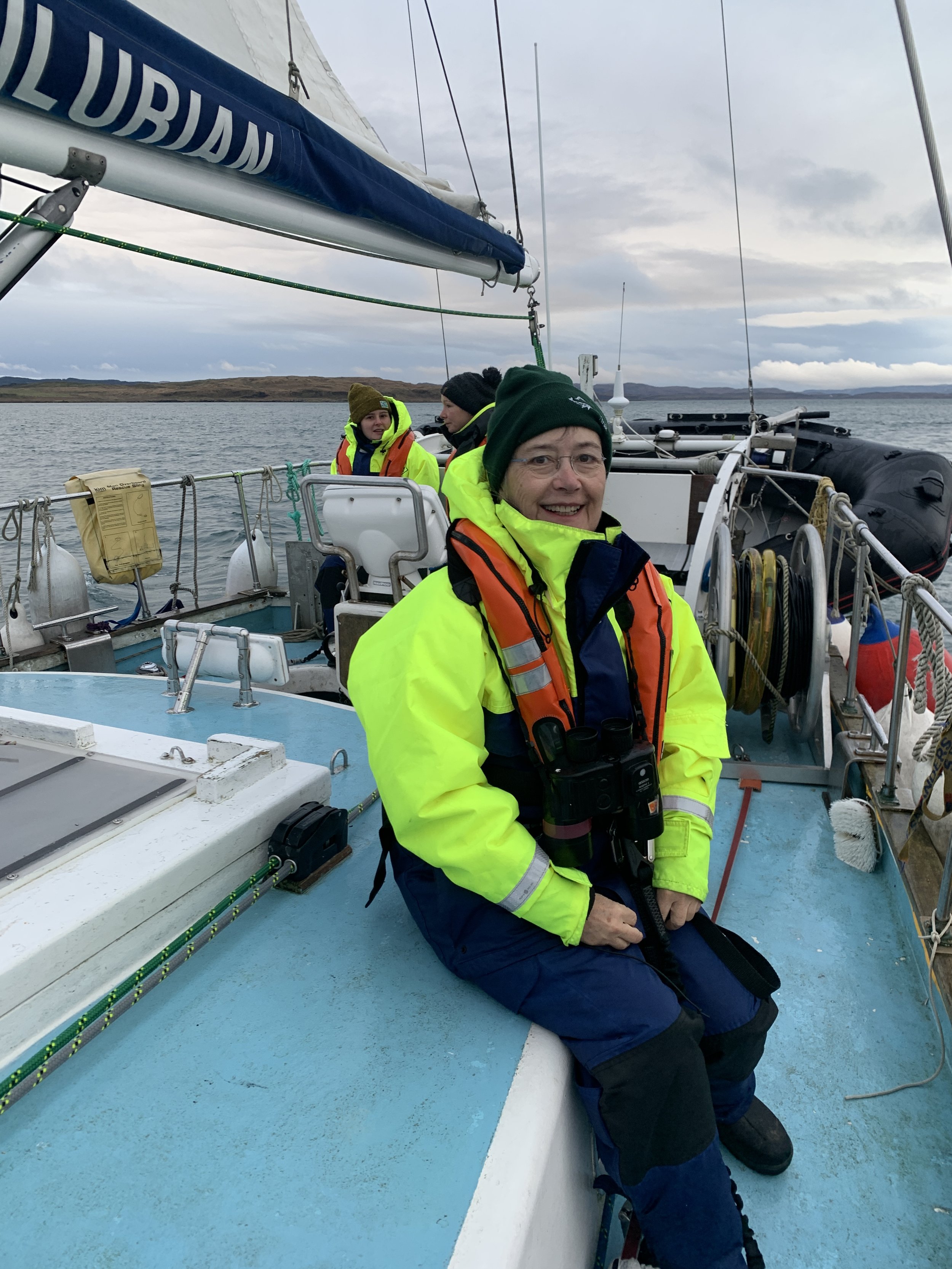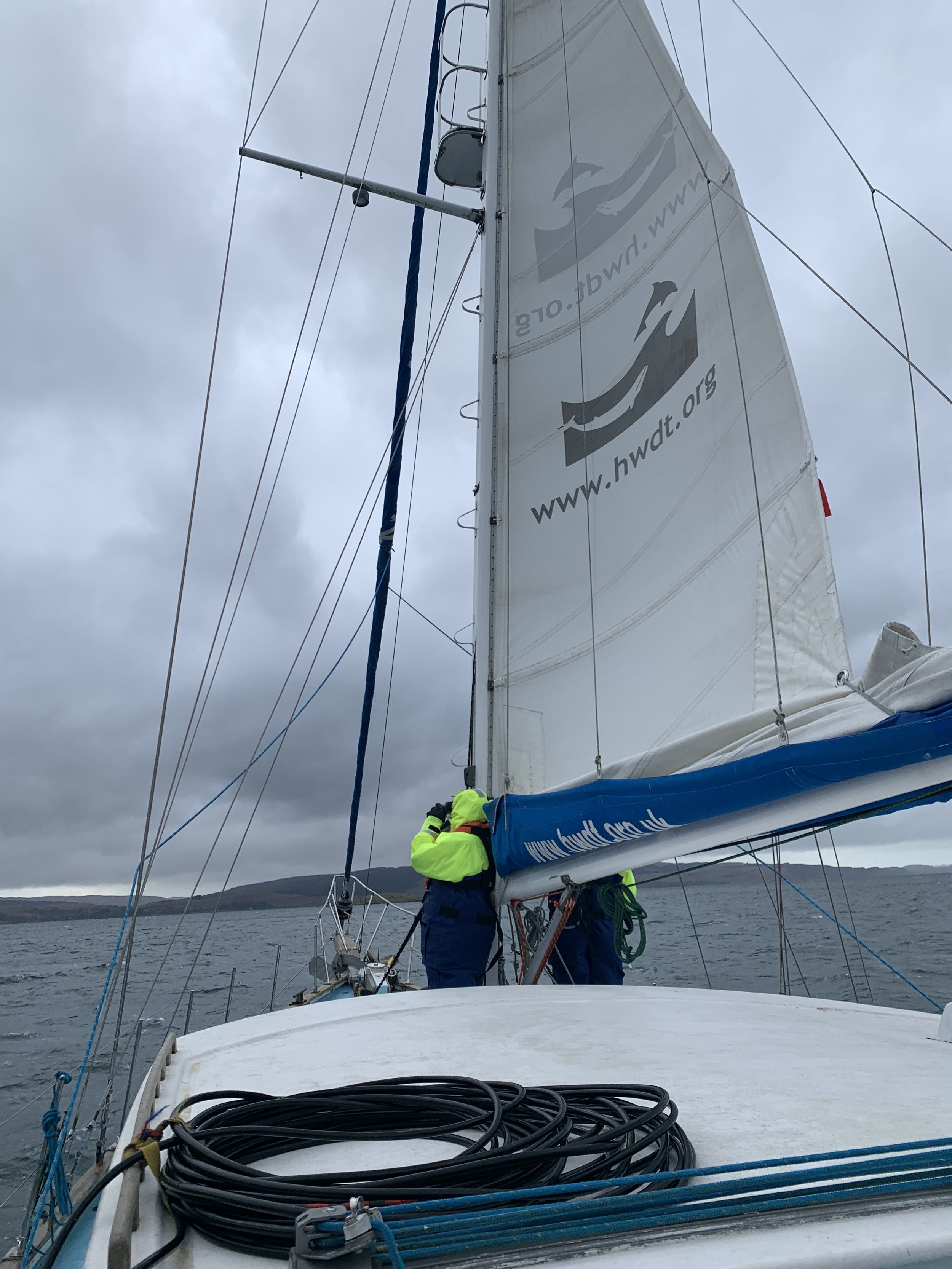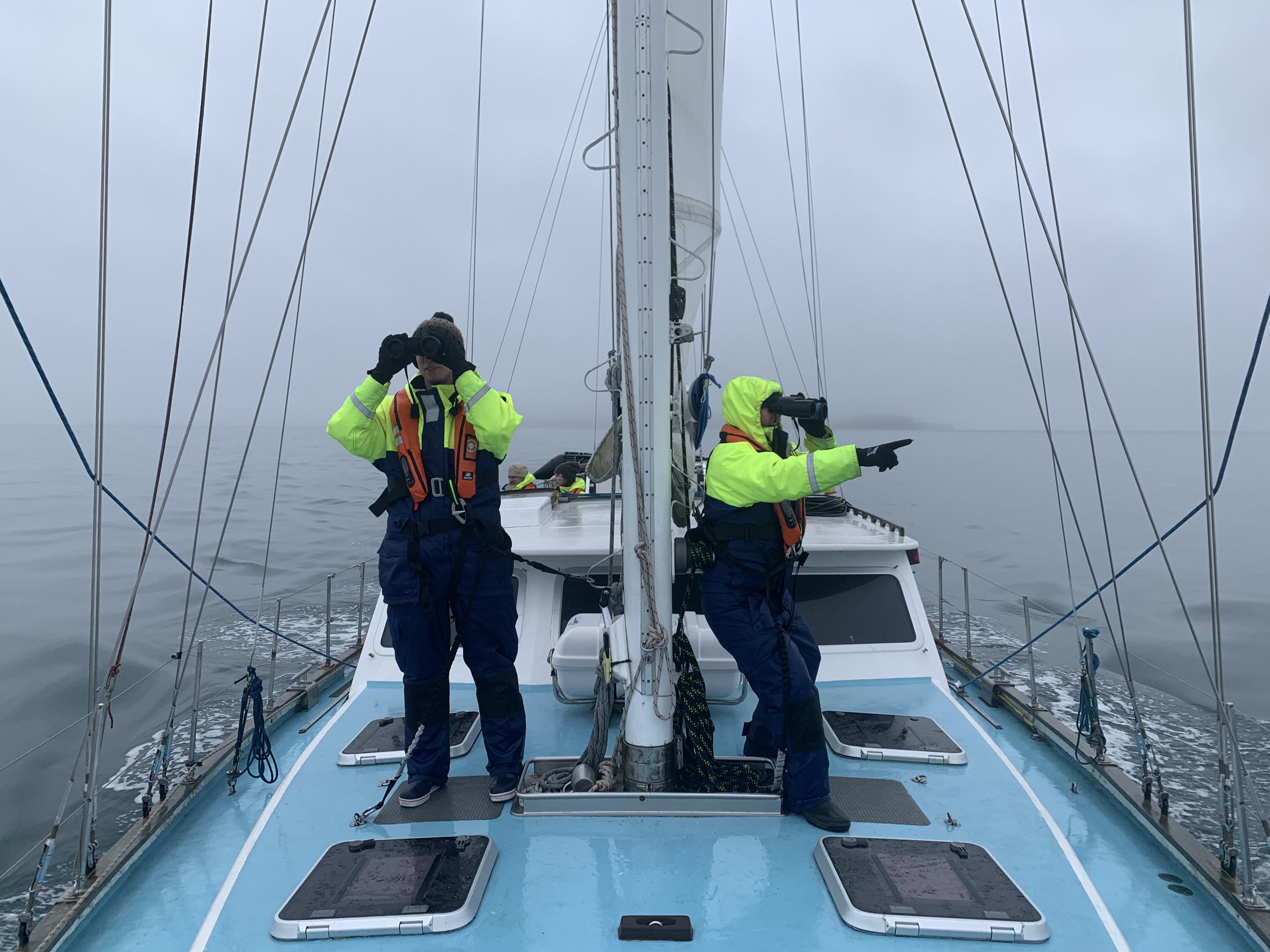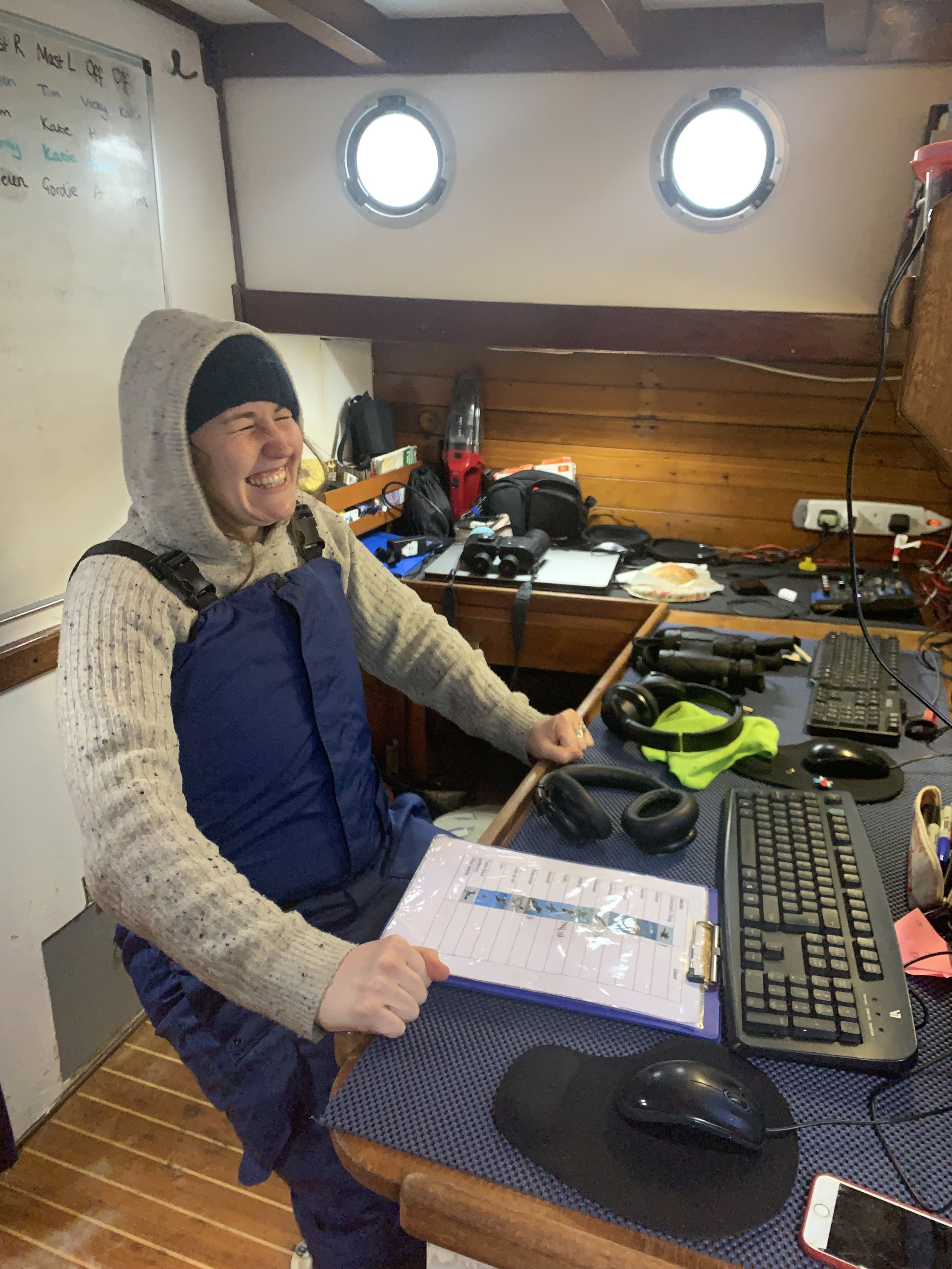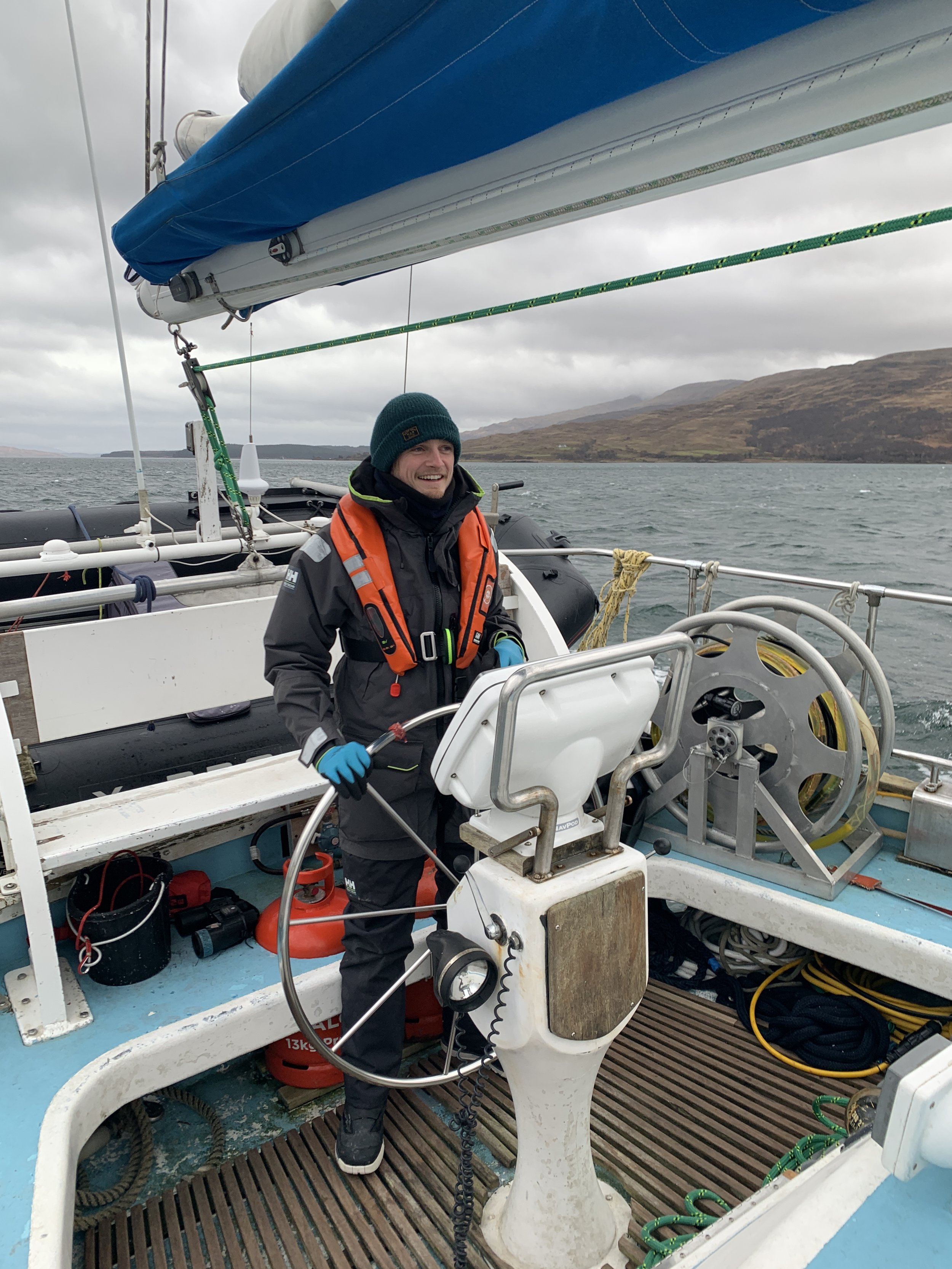Rocking, rolling and really great harbour porpoise on the second winter survey of 2023
Our SECOND winter research expedition of 2023 left Tobermory for a four-day survey to MONITOR THE MARINE ENVIRONMENT OFF THE WEST COAST OF SCOTLAND. WILD WEATHER CREATED SOME CHALLENGES FOR THOSE ON BOARD SILURIAN - OUR RESEARCH VESSEL - BUT THE TEAM WAS REWARDED WITH AN EPIC FINAL DAY! Here Hannah Lightley, Science Officer on board, recalls the trip…
DAY 1
The volunteers, Vicky, Gordie, Amy, Katie, Helen and Tim, arrived bright & early at 9am to board. Our skipper, Emma, gave a safety brief, first mate, Jake showed volunteers around the vessel and introduced the etiquette of life on board. Hannah, our science officer then explained data collection and gave an overview of the species we might encounter. Then it was into our fantastic wet-weather gear and off we set from Tobermory at 11.30am. Sailing down the Sound of Mull into the prevailing south-easterly wind made for lumpy sailing. Spotting conditions were quite difficult and the hardy souls at the mast took a bit of spray, whilst of couple of volunteers felt a bit seasick.
Conditions improved through the day, as we continued down the Sound, but sadly there was not much to record. Highlights for the early part of the day were a pair of eider ducks, a few kittiwakes, a full summer plumage black guillemot and 2 white-tailed eagles. As we rounded the southern tip of Mull, we finally had some sightings to log - mainly creels, until at the last minute, before going off effort we recorded 2 seals.
Having a mix of sightings and creels towards the end of the day allowed us to get the hang of entering data into the science computer and whetting our appetite for surveying over the rest of the week. Once arrived at our anchorage off Kerrera, we practiced estimating the distances of boats, houses and creels around the bay, in anticipation of the many sightings we are hoping to have!
DAY 2
The morning was overcast but stayed dry over breakfast. Hannah was up at 7am to prepare breakfast and we all arrived at the table to see it was adorned with Hannah’s midnight arts and crafts efforts of paper hearts reminding us that it was Valentine’s Day. Emma gave us a chart chat on what her plans were for the day; being extra prepared, Emma had a plan A, B, and C, depending on the weather, but they all generally involved heading south towards the Sound of Jura.
Shortly after we disembarked there was a sighting of a common seal by Tim. We continued traveling down the Firth of Lorn and this part of the journey was calm, with stunning light shining through gaps in the thick blankets of clouds that were lying heavy in the sky. The hills off the port side of the boat were a soft, smooth blue, the gradient dependent on the distance. On the starboard side, the hills of Mull were being battered by wind and rain, the sky turning an angry grey as we were heading through it. We sailed for around an hour against some strong winds and some reasonable swells and during this time the conditions for sightings were difficult. Observing from the mast was a bouncy challenge but the Fladden suits kept us extremely warm, as did the risotto that was delivered at lunchtime!
In the afternoon there were a few sightings of tysties, guillemots and a pair of Canada geese. The crew decided to make for a more sheltered area and headed for the Sound of Luing. We continued down the Sound of Jura, tucking into the coastline when we needed to keep more sheltered. We travelled down as far as Tayvallich Katie spotted another seal, but the species was unidentified! We then turned back on ourselves, heading towards Crinan to find our mooring. The crew stayed aboard to troubleshoot some issues with the hydrophone, but very kindly took the volunteers over to Crinan in the dinghy. We walked along the edge of the canal and Tim seen a Kingfisher! We headed to pub at the Crinan Hotel and enjoyed a dram of Jura and some crisps.
DAY 3
It was an early start today, leaving Crinan at 7.30 am to make use of the tides to take us back home to Mull. The crew began to sail back towards Mull whilst the volunteers ate Hannah’s tasty breakfast underway until it was light enough to conduct visual effort. Sadly, the day started and ended with rain, but luckily for the volunteers, we managed to dodge the worst of it whilst the crew got a soaking. Soon enough we were able to head up on deck and start our visual survey for the day; spirits were high, and we were determined to spot our first cetacean of the trip! We made our way towards the Slate Islands passing Scarba, Lunga and Luing. With Emma’s excellent navigational plan, we were running with the tide witnessing the incredible water movement all around the boat and views of the Corryvrecken ahead. Shortly after we had our first sighting of the day, a common seal as well as lots of seabirds in particular shags.
Heading towards the South of Mull, the swell began to pick up once we left the protection of the Slate Islands reducing visibility. A distinct course change was made allowing the boat to run parallel to the island as we travelled towards the Sound of Mull. Relay became a very busy position as boat traffic began to increase with tankers, fishing vessels and ferries coming into view with the CalMac ferry even going through a rainbow!
Passing Duart Castle, we headed to Craignure where we stopped for a wee lunch break of baked potatoes and chilli allowing the crew to have a bit of respite after their early start as well as collecting some science equipment from boat manager Charlie. After lunch, we had a quick succession of grey seal sightings as well as one unidentified seal. With the group full of beans (literally) we decided to push on towards Tobermory giving ourselves the best chance of heading into open water tomorrow. As conditions remained relatively flat, those who had been feeling unwell over the past few days were able to hang out below deck. Kate managed a whole shift in the science station, and a busy one too with plenty of creels being called below deck!
Hannah was bouncing around as she had managed to fix the acoustic equipment, so we celebrated with some delicious tangfastics. The hydrophone was then deployed and right away we detected harbour porpoises – result! After 6.5 hours of survey effort, we picked up our mooring in Tobermory for the evening and enjoyed Haggis and Tatties whilst watching Steve Truluck’s winter webinar.
DAY 4
We started at 8 am this morning leaving Tobermory and heading straight into the drizzly fog. Within minutes of being ‘on-effort’, Gordie spotted two harbour porpoises from the port side of the mast. Cheers echoed all around the boat as we finally had our first cetacean sighting of the survey! We continued past Tobermory lighthouse where volunteers on the mast noticed lots of bird activity on the starboard side so everyone had their eyes peeled. To our delight, we began to have several sightings of porpoise; at one point Tim saw at least 11 individuals surface at the same time! There were porpoise present all around the boat being very active, swimming and foraging as we passed. Tim noticed that there were several juveniles within the group and Hannah said it was one of the best porpoise encounters she’s had!
We continued in high spirits and over the next hour or so there were several sightings of singles or pairs of harbour porpoise and a couple of grey and common seals! A local fisherman, who has a good relationship with the HWDT radioed over to say that he had spotted a dead porpoise with a corkscrew-type injury. The fisherman managed to take photos which were sent over to Scottish Marine Animal Stranding Scheme (SMASS), who confirmed that the injury was typical of a grey seal attack, which is a relatively novel behaviour that has been observed amongst grey seals around the world. Heading out towards Coll the water was still flat-calm and there was lots of bird activity; guillemots, a few puffins and lots of razorbills. Passing the Cairns of Coll there was little to no sightings; Helen thought she spotted a dolphin ahead in the distance and Gordie thought it was possibly a harbour porpoise, but it was too far away to tell so was recorded as unknown.
Down in the science room, Amy squealed with excitement at hearing dolphin whistles coming through on the hydrophone! Despite the low number of visual sightings, the acoustic data was showing that there were dolphins and harbour porpoise present in the area. The shadows of the Small Isles could be seen in the distance, the fog was gradually lifting and eventually dissolved to reveal the distinctive shape of Rum, Eigg and Muck. At this point, Tim also reported a few bits of rubbish. We about turned and headed back towards Ardnamurchan ,the white form of the lighthouse stark against the winter colours of the headland it marks. We had no sightings from the mast on the return journey, however, Emma and Jake both spotted porpoise from the back of the boat.
As we returned to Tobermory, we celebrated finishing the last survey of the trip! The crew got the boat on the pontoon with some expert manoeuvring, and we all set to work on showing Silurian the love she deserves by giving her a good clean and scrub, inside and out. Tim expertly polished the bell and once Silurian was ship-shape, ready for her next survey - we headed to the pub for a well-earned beer.
Across the 4 days, the group surveyed 148 nautical miles of Hebridean waters encountering 3 different species of marine mammal. These surveys are incredibly important as prior to the programme starting in 2019, very little winter data existed for the region.
Showing the track line of the area surveyed and sightings during HWDT 2023 WINT02.
Thanks to the fantastic team of volunteer citizen scientists who participated in the expedition. Every data point in our vast database is collected by you - members of the public! There are still a few spaces remaining on our 2023 Summer field season expeditions, follow the link below to join the adventure.
WE’D ALSO LIKE TO THANK NATURE SCOT FOR FUNDING THE WINTER PROGRAMME OF SURVEY WORK, BUILDING A MORE COMPREHENSIVE UNDERSTANDING OF THE HEBRIDEAN MARINE ENVIRONMENT.



